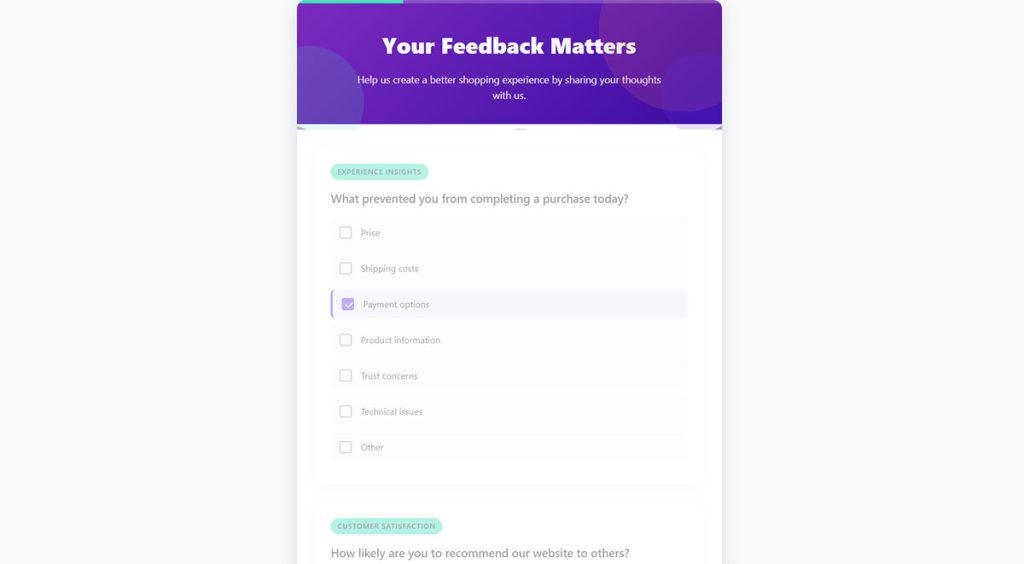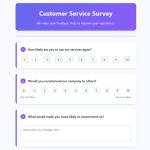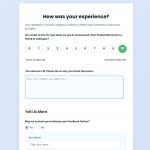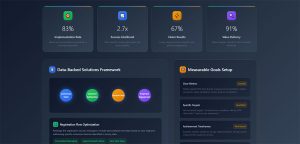You send a survey. Half your audience ignores it. The other half quits halfway through. Sound familiar? Survey fatigue is killing your response rates and destroying data quality. When participants…
Table of Contents
Is your website truly meeting visitor expectations? The answer lies in asking the right website feedback survey questions.
Finding out what users think about your site isn’t just nice to have, it’s essential for growth. Effective user experience questionnaire design can reveal critical insights that analytics alone can’t capture. When properly implemented, these surveys become powerful tools for measuring customer satisfaction metrics and driving meaningful improvements.
By collecting both quantitative feedback methods and qualitative user insights, you’ll identify obstacles in the customer journey touchpoints that might be costing you conversions. Whether you’re using in-page feedback tools or exit intent popups, the key is knowing which questions will generate actionable data.
This guide explores essential survey question types that help measure everything from website usability metrics to overall customer sentiment analysis. You’ll learn how to craft questions that boost response rates while avoiding survey fatigue prevention pitfalls that plague many feedback collection efforts.
Website Feedback Survey Questions
General Experience

Website Navigation Ease
Question: How easy was it to navigate our website?
Type: Multiple Choice (1–5 scale from “Very difficult” to “Very easy”)
Purpose: Evaluates the intuitive design of menus, links, and overall site structure.
When to Ask: After users have explored multiple pages of your website.
Task Completion Success
Question: Did you find what you were looking for today?
Type: Yes/No with optional comment field
Purpose: Directly measures if the website fulfilled the user’s primary goal.
When to Ask: Immediately after a search or at exit intent.
Overall Design Rating
Question: How would you rate the overall design of our website?
Type: Star rating (1-5 stars)
Purpose: Captures general impression of visual appeal and professionalism.
When to Ask: After sufficient exposure to website design elements.
Task Identification
Question: What task were you trying to complete on our website?
Type: Open-ended text field
Purpose: Reveals user intent and most common use cases.
When to Ask: Early in the survey to provide context for later answers.
Visual Design & Layout
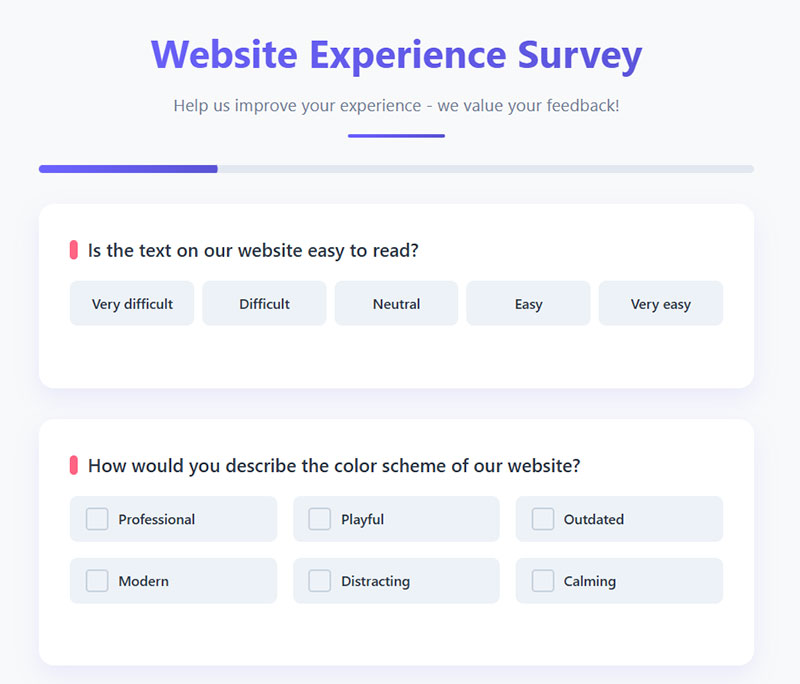
Text Readability
Question: Is the text on our website easy to read?
Type: Multiple Choice (1–5 scale from “Very difficult” to “Very easy”)
Purpose: Assesses font choices, sizes, contrast, and spacing.
When to Ask: After users have read content on multiple pages.
Color Scheme Impression
Question: How would you describe the color scheme of our website?
Type: Multiple select (Professional, Playful, Outdated, Modern, Distracting, Calming, etc.)
Purpose: Evaluates emotional response to brand colors and design choices.
When to Ask: After users have viewed multiple pages with consistent branding.
Distraction Elements
Question: Did any elements of the page distract you from your task?
Type: Yes/No with conditional followup asking which elements
Purpose: Identifies problematic ads, popups, or design elements.
When to Ask: After task completion attempts or abandoned sessions.
Standout Elements
Question: Which page elements stood out most to you?
Type: Multiple select (Header, Navigation menu, Images, Call-to-action buttons, Text content, Footer)
Purpose: Reveals what captures user attention for better design focus.
When to Ask: After sufficient website exposure.
Content Quality
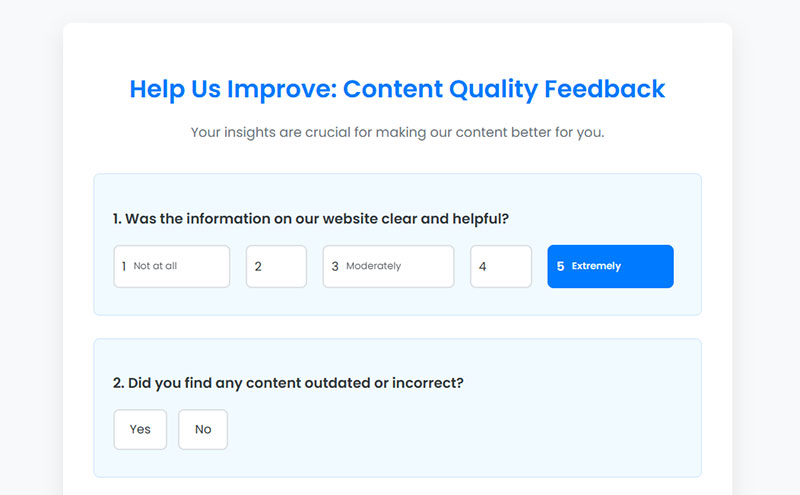
Information Clarity
Question: Was the information on our website clear and helpful?
Type: Multiple Choice (1–5 scale from “Not at all” to “Extremely”)
Purpose: Assesses content quality and communication effectiveness.
When to Ask: After users have consumed key content pages.
Content Accuracy
Question: Did you find any content outdated or incorrect?
Type: Yes/No with conditional followup for details
Purpose: Identifies specific content issues requiring updates.
When to Ask: After users have viewed informational pages.
Content Gaps
Question: What additional information would you like to see on our website?
Type: Open-ended text field
Purpose: Uncovers missing content that users expect or need.
When to Ask: After users have thoroughly explored relevant sections.
Content Relevance
Question: How relevant was our content to your needs?
Type: Multiple Choice (1–5 scale from “Not relevant” to “Extremely relevant”)
Purpose: Measures alignment between content strategy and user expectations.
When to Ask: After users have consumed multiple content pieces.
Functionality
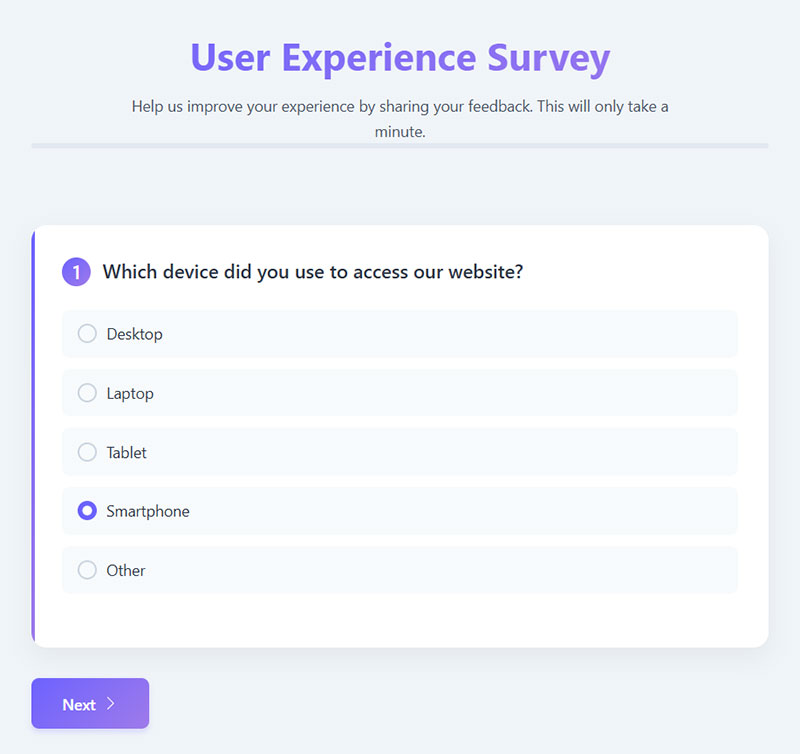
Link Functionality
Question: Did all features and links work as expected?
Type: Yes/No with conditional followup for details
Purpose: Identifies broken links or malfunctioning elements.
When to Ask: After users have clicked multiple links or used interactive features.
Page Load Speed
Question: How fast did pages load for you?
Type: Multiple Choice (1–5 scale from “Very slow” to “Very fast”)
Purpose: Assesses perceived performance and technical issues.
When to Ask: After users have navigated to multiple pages.
Error Messages
Question: Did you encounter any error messages?
Type: Yes/No with conditional followup requesting details
Purpose: Identifies specific technical problems for immediate fixing.
When to Ask: At exit or after completion of multi-step processes.
Device Usage
Question: Which device did you use to access our website?
Type: Multiple choice (Desktop, Laptop, Tablet, Smartphone, Other)
Purpose: Correlates user experience with device type for responsive design improvements.
When to Ask: Early in survey to provide context for other answers.
Conversion Elements
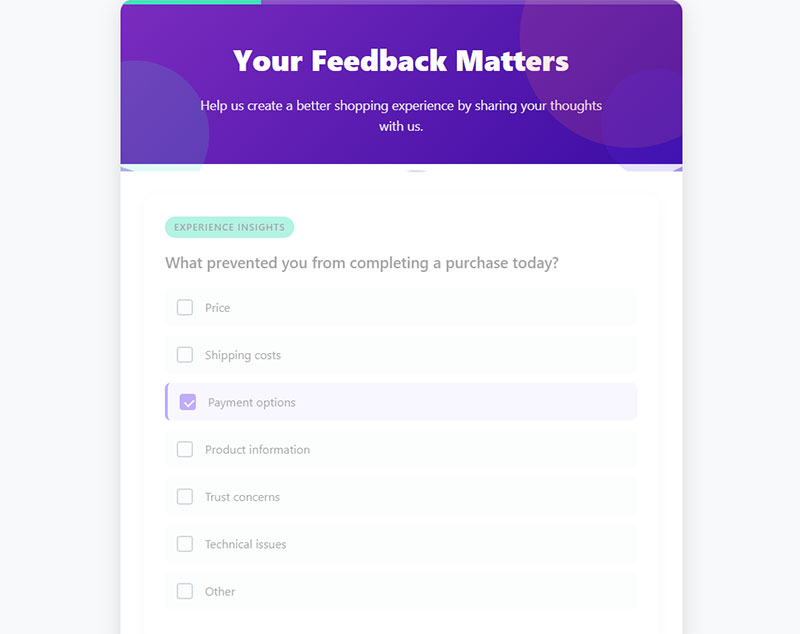
Purchase Barriers
Question: What prevented you from completing a purchase today?
Type: Multiple select (Price, Shipping costs, Payment options, Product information, Trust concerns, Technical issues, Other)
Purpose: Identifies specific obstacles in the conversion funnel.
When to Ask: After cart abandonment or exit intent.
Recommendation Likelihood
Question: How likely are you to recommend our website to others?
Type: NPS scale (0-10)
Purpose: Measures overall satisfaction and potential for word-of-mouth growth.
When to Ask: End of survey or after significant engagement.
Purchase Incentives
Question: What would make you more likely to buy from us?
Type: Multiple select (Lower prices, Free shipping, Better product images, More payment options, Better product descriptions, Faster checkout)
Purpose: Reveals high-impact conversion optimizations.
When to Ask: After cart abandonment or to non-converting visitors.
Pricing Clarity
Question: Was our pricing clearly displayed?
Type: Multiple Choice (1–5 scale from “Not clear at all” to “Very clear”)
Purpose: Assesses transparency and potential confusion points.
When to Ask: After users have viewed product pages or pricing information.
Specific Features
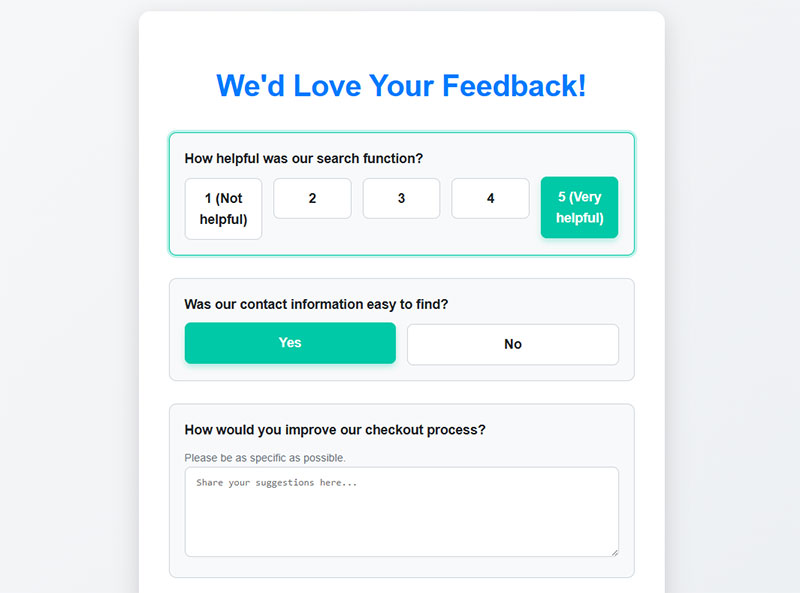
Search Function Utility
Question: How helpful was our search function?
Type: Multiple Choice (1–5 scale from “Not helpful” to “Very helpful”)
Purpose: Evaluates search algorithm effectiveness and result relevance.
When to Ask: After users have used the search function.
Contact Info Findability
Question: Was our contact information easy to find?
Type: Yes/No
Purpose: Assesses accessibility of critical trust-building information.
When to Ask: After users have had reason to look for contact details.
Checkout Process Improvement
Question: How would you improve our checkout process?
Type: Open-ended text field
Purpose: Collects specific suggestions for reducing cart abandonment.
When to Ask: After checkout completion or abandonment.
FAQ Effectiveness
Question: Did our FAQ section answer your questions?
Type: Multiple Choice (1–5 scale from “Not at all” to “Completely”)
Purpose: Evaluates help content comprehensiveness.
When to Ask: After users visit FAQ or help sections.
Open-ended Feedback
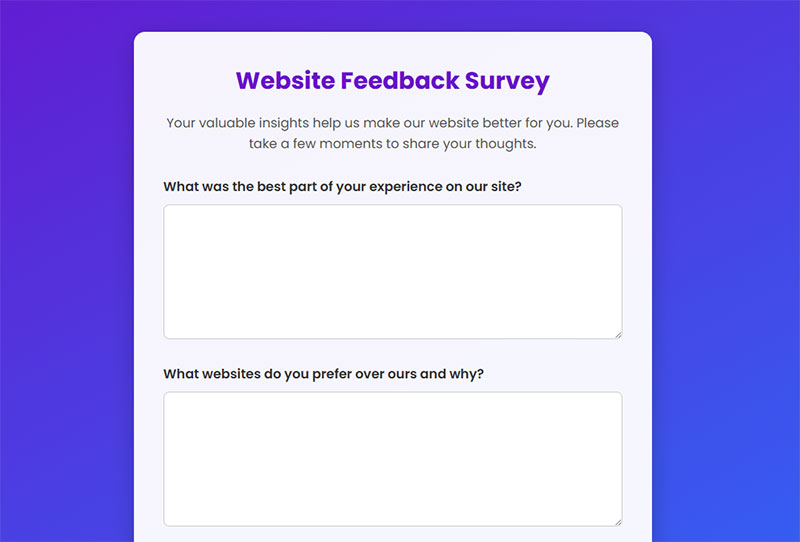
Top Improvement Areas
Question: What three things would you improve about our website?
Type: Open-ended text field
Purpose: Prioritizes improvement areas based on user perspective.
When to Ask: End of survey after all other questions.
Best Experience Element
Question: What was the best part of your experience on our site?
Type: Open-ended text field
Purpose: Identifies strengths to maintain and potentially expand.
When to Ask: After users have explored multiple site areas.
Competitor Comparison
Question: What websites do you prefer over ours and why?
Type: Open-ended text field
Purpose: Reveals competitive advantages and improvement opportunities.
When to Ask: End of survey after establishing rapport.
Additional Feedback
Question: Is there anything else you’d like to tell us?
Type: Open-ended text field
Purpose: Catches valuable insights not covered by other questions.
When to Ask: As final survey question.
FAQ on Website Feedback Survey Questions
What types of survey questions work best for website feedback?
The most effective questions blend Likert scale questions with strategic open-ended feedback opportunities. Using a mix of types of survey questions helps capture both measurable metrics and deeper insights. For comprehensive data, include task completion questions alongside customer pain points inquiries that reveal usability issues your analytics might miss.
How many questions should I include in my website feedback survey?
Keep it brief. Survey response rates plummet with length. For microsurveys, 2-3 questions is ideal. For comprehensive website evaluation criteria, limit to 7-10 questions maximum. Remember that survey fatigue prevention is crucial; users abandon lengthy questionnaires. Focus on quality over quantity to maintain engagement throughout the user testing questions.
When is the best time to display feedback surveys?
Timing dramatically impacts survey participation incentives. Show surveys after meaningful interactions, like completed purchases or multiple page views. Avoid interrupting users mid-task with post-interaction surveys. Consider using exit intent popups for visitors about to leave, as they’ve already completed their journey and may provide honest feedback.
How can I increase response rates for my feedback surveys?
Boost participation by clearly explaining the survey’s purpose and time commitment. Use survey design best practices with visually appealing feedback form templates and implement survey branching logic to show only relevant questions. Consider offering incentives while ensuring your form design is optimized for quick completion.
Should I use open-ended or multiple-choice questions?
Both serve different purposes. Multiple choice questions provide quantifiable data through website rating systems that’s easy to analyze. Open-ended feedback captures unexpected insights and user language. The best website usability survey questions combine both types, with survey form templates providing structured responses while allowing for elaboration on key points.
How do I analyze the feedback data effectively?
Use feedback analysis tools to identify patterns across responses. Look for recurring themes in qualitative answers and track metrics like Net Promoter Score or Customer Effort Score over time. Integrate website analytics integration to correlate feedback with actual user behavior. Focus on actionable insights rather than vanity metrics.
What’s the difference between NPS, CSAT, and CES questions?
These are distinct customer opinion gathering methodologies. NPS (Net Promoter Score) measures loyalty with likelihood-to-recommend questions. CSAT (Customer Satisfaction Score) gauges satisfaction with specific interactions. CES (Customer Effort Score) evaluates ease-of-use. Each provides unique user satisfaction measurement insights when included in your survey form.
How can I ensure my survey forms are accessible to all users?
Implement proper form accessibility standards by using clear labels, providing keyboard navigation, ensuring color contrast, and supporting screen readers. Test your website feedback widgets with diverse users. Consider mobile responsiveness feedback since many users complete surveys on smartphones and tablets.
Should my surveys be anonymous or collect user information?
It depends on your goals. Anonymous surveys with respondent anonymity options often receive more honest feedback, especially for critique. However, collecting basic information allows for segmentation and personalized follow-up. Balance privacy concerns with data needs while being transparent about how information will be used.
How frequently should I collect website feedback?
Avoid overwhelming users with constant website feedback forms. Instead, implement a strategic cadence based on your site updates and traffic volume. Consider continuous collection through subtle feedback collection methods like persistent widgets, alongside periodic deeper digital experience feedback campaigns after major changes or quarterly for benchmarking website satisfaction scores.
Conclusion
Crafting effective website feedback survey questions transforms raw data into strategic insights. When implemented correctly, these tools reveal the voice of your customers in ways that traditional analytics cannot capture.
The key to successful website performance surveys lies in balancing brevity with depth. Your survey question formatting should prioritize clarity while using user behavior questions that target specific aspects of the digital experience feedback. Remember that increasing form conversions starts with respecting your users’ time and attention.
User interface evaluation isn’t a one-time effort but an ongoing process. Implement conversational forms for higher engagement rates and consider using A/B testing feedback to refine your approach. The most valuable insights often come from post-purchase survey questions when the experience is fresh in customers’ minds.
By consistently gathering website navigation feedback and acting on those insights, you transform every user interaction into an opportunity for meaningful improvement.


